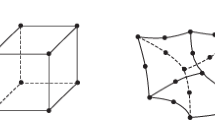Abstract
A high-order accurate flow solver based on a discontinuous Galerkin method has been developed for the numerical simulation of vortex convection and wave propagation on unstructured meshes. To assess the performance of the present flow solver, a vortex convection problem in freestream and an acoustic benchmark problem were tested. An airfoil-vortex interaction problem was also simulated by coupling the flow solver with a dynamic mesh adaptation technique. From the mesh resolution test, the present fourth-order discontinuous Galerkin method almost perfectly preserves the vortex and also accurately resolves the acoustic waves on a mesh with an element size of half of characteristic length. It was also observed that the fourth-order method is more than ten times efficient, in terms of the number of degrees of freedom and the elapsed CPU time, compared to the second-order method.
Similar content being viewed by others
References
E. B. Wake and D. Choi, Investigation of high-order upwinded differencing for vortex convection, AIAA Journal, 34(2) (1996) 332–337.
J. G. Leishman, Principles of helicopter aerodynamics, Cambridge University Press (2006).
F. Caradonna et al., Methods for the prediction of bladevortex interaction noise, Journal of the American Helicopter Society, 45(4) (2000) 303–317.
C. R. Srinivasan, W. J. McCroskey and J. D. Baeder, Aerodynamics of two-dimensional blade-vortex interaction, AIAA Journal, 24(10) (1986) 1569–1576.
M. Damodaran and D. A. Caughey, Finite-volume calculation of inviscid transonic airfoil-vortex interaction, AIAA Journal, 26(11) (1988) 1346–1353.
J. Steinhoff and G. K. Raviprakash, Navier-Stokes computation of blade-vortex interaction using vorticity confinement, AIAA Paper 95-0161 (1995).
M. Murayama, K. Nakahashi and S. Obayashi, Numerical simulation of vortical flows using vorticity confinement coupled with unstructured grid, AIAA Paper 2001-0606 (2001).
R. Morvant, K. J. Badcock and B. E. Richards, Airfoilvortex interaction using the compressible vorticity confinement method, AIAA Journal, 43(1) (2005) 63–75.
M. M. Rai, Navier-Stokes simulation of blade-vortex interaction using high-order accurate upwind schemes, AIAA Paper 87-0543 (1987).
S. Lee and D. Bershader, Head-on parallel blade-vortex interaction, AIAA Journal, 32(1) (1994) 16–22.
L. Tang and J. D. Baeder, Improving Godunov-type reconstructions for simulation of vortex-dominated flows, Journal of Computational Physics, 213(2) (2006) 659–675.
L. Tang and J. D. Baeder, Adaptive Euler simulations of airfoil-vortex interaction, International Journal for Numerical Methods in Fluids, 53(5) (2007) 777–792.
C. J. Hwang and J. Y. Kuo, Adaptive finite volume upwind approaches for aeroacoustic computations, AIAA Journal, 35(8) (1997) 1286–1293.
W. S. Oh, J. S. Kim and O. J. Kwon, Numerical simulation of two-dimensional blade-vortex interactions using unstructured adaptive meshes, AIAA Journal, 40(3) (2002) 474–480.
W. S. Oh, J. S. Kim and O. J. Kwon, Time-accurate Navier-Stokes simulation of vortex convection using an unstructured dynamic mesh procedure, Computers & Fluids, 32(5) (2003) 727–749.
B. Cockburn and C. W. Shu, The Runge-Kutta discontinuous Galerkin method for conservation laws V: Multidimensional systems, Journal of Computational Physics, 141(2) (1998) 199–224.
B. Cockburn, G. Karniadakis and C. W. Shu, Discontinuous Galerkin methods: theory, computation, and applications, Lecture Notes in Computational Science and Engineering, Springer, New York (1999).
P. L. Roe, Approximate Riemann solvers, parameter vectors, and difference schemes, Journal of Computational Physics, 43(2) (1981) 357–371.
S. Gottlieb and C. W. Shu, Total variation diminishing Runge-Kutta schemes, Mathematics of Computation, 67(221) (1998) 73–85.
R. Hartmann, Discontinuous Galerkin methods for compressible flows: higher order accuracy, error estimation and adaptivity, VKI LS 2006-01: CFD — Higher Order Discretization Methods, Belgium (2005).
P. Solin, P. Segeth and I. Zel, Higher-order finite element methods, Studies in Advanced Mathematics, Chapman and Hall (2003).
F. Bassi and S. Rebay, High-order accurate discontinuous finite element solution of the 2D Euler equations, Journal of Computational Physics, 138(2) (1997) 251–285.
M. P. Scully, Computation of helicopter rotor wake geometry and its influence on rotor harmonic loads, ASRL TR-178-1, Massachusetts Institute of Technology (1975).
M. D. Dahl, Fourth Computational Aeroacoustics (CAA) Workshop on Benchmark Problems, NASA CP-2004-212954 (2004).
H. M. Lent, G. E. A. Meier, K. J. Muller, F. Obermeier, U. Schievelbusch and O. Schurmann, Mechanisms of transonic blade-vortex interaction noise, Journal of Aircraft, 30(1) (1993) 88–93.
Author information
Authors and Affiliations
Corresponding author
Additional information
Recommended by Associate Editor Byeong Rog Shin
Hee Dong Lee is a Ph. D student at the Computational Aerodynamics and Design Optimization Laboratory in the department of aerospace engineering, KAIST, Korea. His research interests are in computational simulations based on discontinuous Galerkin methods and high-order schemes.
Oh Joon Kwon is a professor in the Department of Aerospace Engineering, KAIST, Korea. His research interests are in computational algorithm development and numerical simulation based on unstructured meshes for a variety of applied aerodynamic problems.
Rights and permissions
About this article
Cite this article
Lee, H.D., Kwon, O.J. Assessment of a high-order discontinuous Galerkin method for vortex convection and wave propagation on unstructured meshes. J Mech Sci Technol 27, 3331–3346 (2013). https://doi.org/10.1007/s12206-013-0855-7
Received:
Revised:
Accepted:
Published:
Issue Date:
DOI: https://doi.org/10.1007/s12206-013-0855-7




